Herbstlabyrinth-Adventhöhle-System
Useful Information
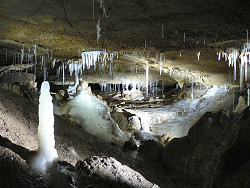
© Marco Dienst
| Location: |
Between Breitscheid and Erdbach.
Ticket office in the town hall of Breitscheid.
(50.687548, 8.208449) |
| Open: |
APR to OCT Sat, Sun, Hol 11-18. [2024] |
| Fee: |
Adults EUR 9, Children (4-14) EUR 6, Children (0-3) free. Groups (-13): Per Group EUR 104. [2024] |
| Classification: |
 Karst Cave Karst Cave
|
| Light: |
 LED LED
|
| Dimension: | L=13.070 m, VR=86 m, T=8 °C. |
| Guided tours: | D=45 min, St=124, L=45 m, VR=21 m. |
| Photography: | allowed, no flash |
| Accessibility: | no |
| Bibliography: |
Ingo Dorsten, Annette Hüser, Thomas Hülsmann (2006):
Das Herbstlabyrinth-Adventhöhle-System - Die erste Riesenhöhle Hessens,
Speläologische Arbeitsgemeinschaft Hessen e.V.
 online
( online
( ) )
|
| Address: |
Tourist-Info Breitscheid, Rathausstraße 14, 35767 Breitscheid, Tel: +49-2777-913-321.
E-mail: Ticket-Hotline: +49-231-917-2290. |
| As far as we know this information was accurate when it was published (see years in brackets), but may have changed since then. Please check rates and details directly with the companies in question if you need more recent info. |
|
History
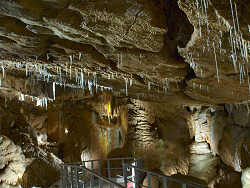
© Alexander Chrapko, GermTec, The Cave Lighting™ project
| 11-DEC-1993 | Adventhöhle discovered by members of the Speläologische Arbeitsgruppe Hessen (SAH). |
| 28-MAY-1994 | Herbstlabyrinth discovered. |
| 1995 | Adventhöhle and Herbstlabyrinth connected. |
| 1997 | pause in exploration due to a lack of permit. |
| 1999 | cave declared a natural monument. |
| 2002 | exploration continued. |
| 2002 | Nordgang discovered and surveyed for 1,400 m. |
| 2004 | Wolkenschlösschen discovered. |
| 2005 | discovery of tufa from the Laacher-See-Vulkan eruption. |
| 2007 | start of development. |
| 09-MAY-2009 | opening of the show cave. |
Description
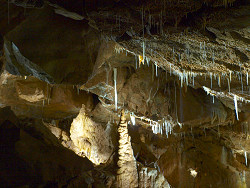
© Alexander Chrapko, GermTec, The Cave Lighting™ project
The Herbstlabyrinth is the most recent show cave of Germany, opened in 2009. The show cave allows the visit of a single chamber of the Herbstlabyrinth-Adventhöhle-Systems, called Knöpfchenhalle (Bulbous Calcite Chamber), by an artificial entrance tunnel. A staircase leads down into the cave. The trail inside the cave was constructed as an elevated path made of glass-reinforced plastic, which required no damage to the cave itself. The trail could be removed and the cave would be almost unchanged. The lighting of the cave was installed by GermTec, a local company founded by cavers, and is based on latest LED technology. This reduces the amount of light and heat emitted by the lamps, and as a result the amount of lampenflora. Additionally, it reduces the cost of changing lamps and for electricity. The cave is visited by small groups of up to 13 people, the number of tours per day is restricted. This is intentional, to limit the impact of the visits on the cave as an ecosystem.
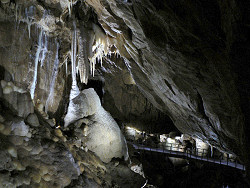
© Marco Dienst
It is advisable to book tickets in advance online via the website or by telephone. There is a small car park at the cave, but if this is full, there are two alternatives. From Breitscheid town hall, a path about one kilometre long leads parallel to the country road to the cave. In Erdbach, follow the Mühlweg to the cave car park on the edge of the village, from here a very interesting path leads to the cave, which as a karst hiking trail has many geotopes to offer. It also leads through the wild and romantic Gasseschlucht gorge. The path is no longer than one kilometre, but due to the considerable elevation gain of almost 100 m, you should definitely plan 30 minutes for the hike.
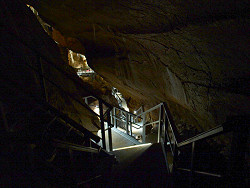
© Alexander Chrapko, GermTec, The Cave Lighting™ project
The small karst area near Breitscheid is a Devonian reef with a size of 2.5 km² and is used for quarrying limestone for many years. Limestone is needed for various purposes, but still it is rather low price, and preferably it is quarried as close as possible to the consumer to reduce transport costs. In the Westerwald area, which consists mainly of crystalline rocks, the demand for limestone is obviously rather high. But the special features of this small patch of limestone were early known and easy to see: the typical features of contact karst. This means water forms rivers all around the limestone and runs on the surface, but as soon as it gets in contact with the limestone it is loosing in a swallow hole running underground through caves. The water is able to dissolve a lot of limestone, as the surrounding crystalline rocks are insoluble and so the water is undersatutated when it reaches the limestone. The water reappears at the other side of the limestone patch in karst springs and runs above ground again.
Swallow holes and springs were long known, and the swallow holes were the first caves which were explored. The idea was to find the huge cave system formed the underground river. The efforts, which included digging and pumping, were only a partial success. The cave system was never discovered, the digging was futile as the water of the snow melt filled the swallow hole again. However, several deep vertical caves of some 100 m depth were surveyed. Today the swallow holes are one stop on the new karst trail.
The discovery of the Herbstlabyrinth was made during the quarrying work, which was responsible both for the discovery and for the destruction of a part of the cave system. But after the importance of the cave became widely known, it was protected and the quarrying continued in another part of the area. Today the cave is protected by both nature conservation and heritage conservation law. One of the reasons for this is the development as a show cave, which makes the cave known to the public and allows the public to accept that it deserves preservation.
Most show caves in Germany were developed at the end of the 19th century and after second world war. Both were times or boasting economies and growing tourism. Actually, we have a different situation, the leisure activities change from the consummation of historic buildings and museums to activities like high-wire forest adventures. Show caves offer guided tours and are more like a natural history museum. Most German show caves lose visitors every year now. So actually, despite its obvious beauty, it is rather weird to create a new show cave under such business conditions. The solution is rather simple: this state has very little limestone and caves, very little show caves, which result in a rather huge catchment area. The locals and the local politicians were much interested in the development of the cave, which was also supported by the cavers. The cavers were hoping for effective protection of the cave due to economic interests and public awareness, which obviously worked very well.

|
| Herbstlabyrinth Gallery |
- See also
 Search DuckDuckGo for "Herbstlabyrinth-Adventhöhle-System"
Search DuckDuckGo for "Herbstlabyrinth-Adventhöhle-System" Google Earth Placemark
Google Earth Placemark Herbstlabyrinth-Adventhöhle-System
Herbstlabyrinth-Adventhöhle-System  - Wikipedia (visited: 11-JAN-2024)
- Wikipedia (visited: 11-JAN-2024) Herbstlabyrinth Schauhöhle Breitscheid, official website
Herbstlabyrinth Schauhöhle Breitscheid, official website  (visited: 11-JAN-2024)
(visited: 11-JAN-2024) Schauhöhle Herbstlabyrinth Breitscheid
Schauhöhle Herbstlabyrinth Breitscheid  (visited: 11-JAN-2024)
(visited: 11-JAN-2024) Speläologische Arbeitsgemeinschaft Hessen e. V. (SAH)
Speläologische Arbeitsgemeinschaft Hessen e. V. (SAH)  (visited: 11-JAN-2024)
(visited: 11-JAN-2024) Unterrichtsprojekt "Färbeversuche am Erdbach"
Unterrichtsprojekt "Färbeversuche am Erdbach"  (visited: 11-JAN-2024)
(visited: 11-JAN-2024) SG’86 Nachrichten - Herbstlabyrinth-Adventhöhlensystem Naturdenkmal
SG’86 Nachrichten - Herbstlabyrinth-Adventhöhlensystem Naturdenkmal  (visited: 11-JAN-2024)
(visited: 11-JAN-2024)
 Index
Index Topics
Topics Hierarchical
Hierarchical Countries
Countries Maps
Maps